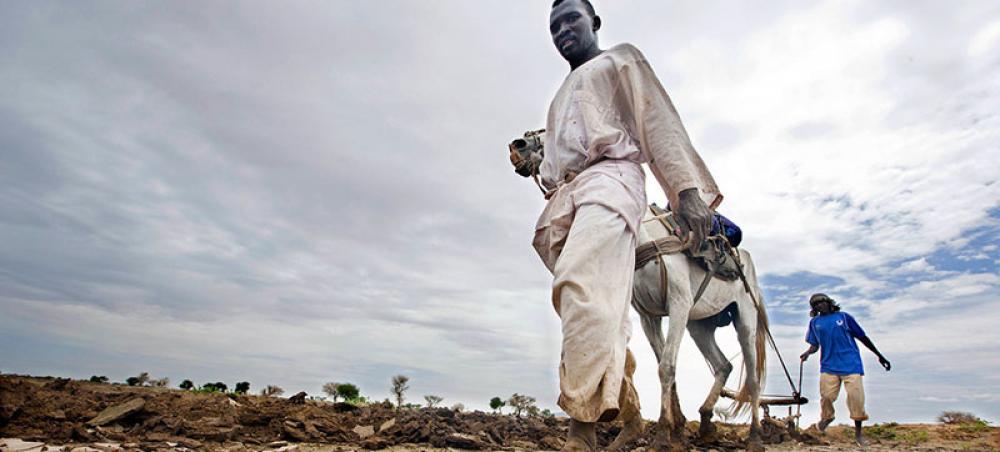Just Earth News | @justearthnews | 01 Oct 2021, 01:45 am Print
 Image: UN Photo/Albert González Farran
Image: UN Photo/Albert González Farran FAO
New York:: The first-ever stocktake of Africa’s forests and landscapes, which was released on Wednesday finds slow progress in repairing Africa’s degraded lands and urges ramped up efforts for climate action.
Launched during Africa Climate Week, and the UN Decade on Ecosystem Restoration, the Review of Forest and Landscape Restoration in Africa 2021, shows, that more needs to be done to tap the continent’s opportunity to return land to sustainable production, protect biodiversity, and shield livelihoods in the battle against climate change.
“Despite our efforts, every year more forest disappears, costing the continent a three per cent loss of GDP”, said Abebe Haile-Gabriel, Food and Agriculture Organization’s (FAO) Assistant Director-General and Regional Representative for Africa.
The analysis has been published by FAO together with the African Union Development Agency-NEPAD.
A grim assessment
Up to 65 per cent of productive land is degraded, while desertification affects 45 per cent of Africa’s land area, according to the review.
And while the overall trend is moving downward, net loss of forests is still increasing in Africa, with four million hectares of forest disappearing every year.
Moreover, Africa’s drylands are increasingly more vulnerable to climate change and their restoration is a priority for adaptation and building resilient and sustainable food systems.
“Degraded forest landscapes intensify the effects of climate change and are a barrier to building resilient and prosperous communities when 60 percent of Africans depend on their land and their forests”, said the FAO official.
Local engagement is key
Most of the projects assessed in the Review have a strong climate change dimension that not only aims to sequester carbon but also to create jobs and reduce the vulnerabilities of rural people to food insecurity.
A quick glance
Africa has one billion hectares of drylands, 393 million hectares of which need restoration in Africa’s Great Green Wall areas.
AFR100 has committed 31 African Governments to restoring 100 million hectares by 2030 – a challenge already exceeded.
Africa has an estimated additional 132 million hectares of degraded cropland, which combined with climate change, makes millions more vulnerable.
Around 45 percent of Africa’s land is impacted by desertification, 55 per cent of which is at very high risk of further desertification.
The report identifies local ownership as being fundamental for success, while high-level political support and access to finance are also crucial.
“Extending well beyond tree-planting, forest and landscape restoration is an all-encompassing approach to returning trees and forests to landscapes where they have been lost and is of great benefit to sustainable food production, building resilience and disaster risk reduction”, said Nora Berrahmouni, FAO Senior Forestry Officer covering Africa, and one of the review’s lead authors.
Trials ahead
Difficulties with longer-term finance, land tenure and property rights are major challenges, according to the assessment.
Other roadblocks include insecurity and conflict, lack of technical capacity and restricted access due to poor infrastructure.
“African countries and their partners need to continue to scale-up their efforts in forest and landscape restoration as a viable solution to climate change and building forward better in response to COVID-19, while also protecting their natural capital”, said Ms. Berrahmouni.
“It’s a long-term process but it is a sustainable, forward-looking solution”, she added.
- New form of 'religious fascism': Bangladesh students, cultural activists protest arrest of Baul singer for hurting religious sentiments
- NY Mayor-elect Mamdani backs Starbucks strike: 'No Contract, No Coffee'
- Unprecedented housing emergency hits Ukraine — Millions struggle for shelter amid ongoing conflict against Russia
- Israel-Hamas crisis: Nearly every child is showing signs of trauma after years of conflict in Gaza, shows report
- Baloch Martyrs’ Day in Berlin: Activists slam Pakistan, demand ‘Free Balochistan’



-1763561110.jpg)


